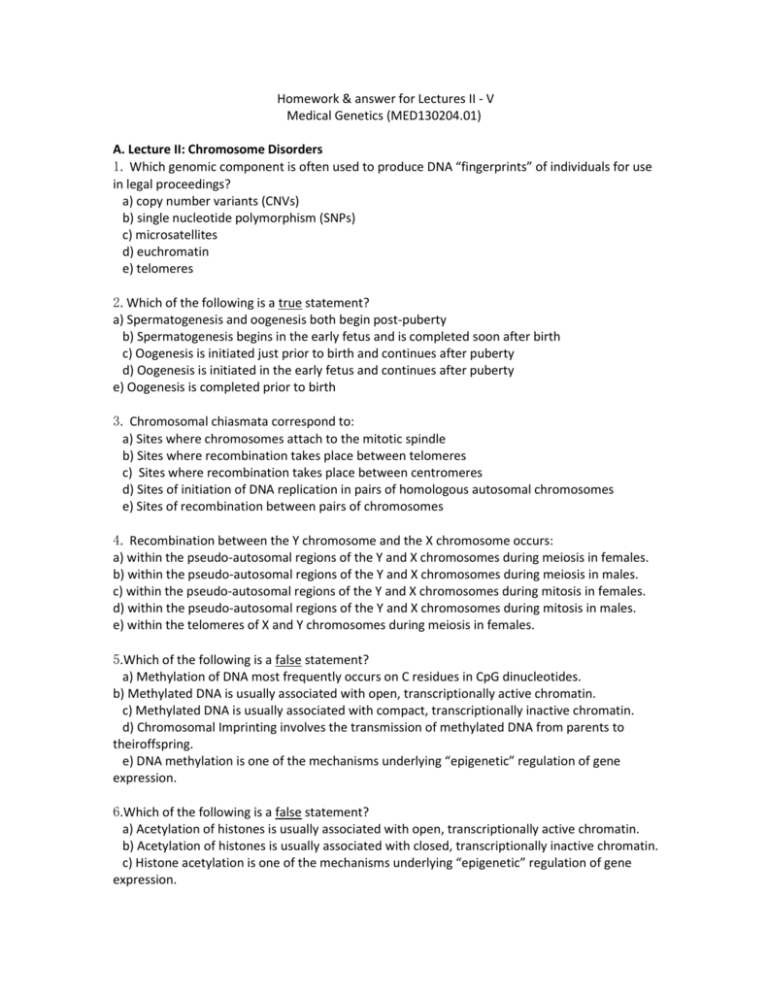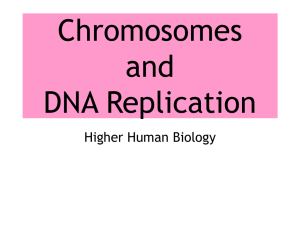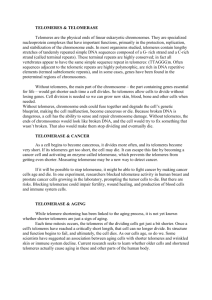Homework & answer for Lectures II
advertisement

Homework & answer for Lectures II - V Medical Genetics (MED130204.01) A. Lecture II: Chromosome Disorders 1. Which genomic component is often used to produce DNA “fingerprints” of individuals for use in legal proceedings? a) copy number variants (CNVs) b) single nucleotide polymorphism (SNPs) c) microsatellites d) euchromatin e) telomeres 2. Which of the following is a true statement? a) Spermatogenesis and oogenesis both begin post-puberty b) Spermatogenesis begins in the early fetus and is completed soon after birth c) Oogenesis is initiated just prior to birth and continues after puberty d) Oogenesis is initiated in the early fetus and continues after puberty e) Oogenesis is completed prior to birth 3. Chromosomal chiasmata correspond to: a) Sites where chromosomes attach to the mitotic spindle b) Sites where recombination takes place between telomeres c) Sites where recombination takes place between centromeres d) Sites of initiation of DNA replication in pairs of homologous autosomal chromosomes e) Sites of recombination between pairs of chromosomes 4. Recombination between the Y chromosome and the X chromosome occurs: a) within the pseudo-autosomal regions of the Y and X chromosomes during meiosis in females. b) within the pseudo-autosomal regions of the Y and X chromosomes during meiosis in males. c) within the pseudo-autosomal regions of the Y and X chromosomes during mitosis in females. d) within the pseudo-autosomal regions of the Y and X chromosomes during mitosis in males. e) within the telomeres of X and Y chromosomes during meiosis in females. 5.Which of the following is a false statement? a) Methylation of DNA most frequently occurs on C residues in CpG dinucleotides. b) Methylated DNA is usually associated with open, transcriptionally active chromatin. c) Methylated DNA is usually associated with compact, transcriptionally inactive chromatin. d) Chromosomal Imprinting involves the transmission of methylated DNA from parents to theiroffspring. e) DNA methylation is one of the mechanisms underlying “epigenetic” regulation of gene expression. 6.Which of the following is a false statement? a) Acetylation of histones is usually associated with open, transcriptionally active chromatin. b) Acetylation of histones is usually associated with closed, transcriptionally inactive chromatin. c) Histone acetylation is one of the mechanisms underlying “epigenetic” regulation of gene expression. d) Histone acetylation is catalyzed by histone acetyltransferases (HATs). e) Removal of acetyl groups from histones is catalyzed by histone deacetylases (HDACs). 7. Which of the following is a false statement? a) The enzyme telomerase catalyzes the shortening of chromosomal telomeres. b) The enzyme telomerase catalyzes the lengthening of chromosomal telomeres. c) In many types of cells, telomeres become a little shorter with each cell division. d) The progressive shortening of telomeres is caused by the inability to prime synthesis of the lagging DNA strand. e) Abnormal shortening of telomeres causes chromosome instability and cell death. B. Lecture III: Single Gene Disorders 8. Which of the following is a false statement? a)“locus heterogeneity” refers to the existence ofmutationswithin different genes (different loci)that cause the same genetic disease (or phenotypes). b) “allelic heterogeneity” refers to the existence of mutations orgenetic variants located within the same gene (i.e, the same locus)thatproduce similar phenotypes or sometimes different phenotypes. c) the mutation that causes sickle-cell anemia is an example of a toxic-gain-of-function mutation. d) toxic-gain-of-function mutations are always dominant mutations. e) haploinsufficiency is a molecular mechanism used to describe cases where inactivation of one of two autosomalalleles is sufficient to cause a disease. C. Lecture IV: Complex Disorders 9. Which of the following statements is false? a) The resolution of gene mapping in pedigrees-based linkage studies is generally lower than gene mapping in population-based case-control studies. b) Gene mapping in both pedigree- and population-based studies depends upon physical linkage between genetic markers and disease producing genetic variants. c) Roughly 70 homologous recombinations take place between chromosomes during the production of eggs and 50 homologous recombinations take place during the production of sperm. d) X and Y chromosomes do not undergo homologous recombination during the production of sperm because they are not homologous chromosomes. e) Genetic markers that become separated during meiosis with a frequency of ~ 1% are located the same chromosome within a distance of (roughly) 1 million bp. 10. Which of the following is a false statement? a) All of us harbor many benign and potentially pathogenic genetic variants in our genomes. b) The rate of production of de novo point mutations in the human genome is roughly 1.2 x 10-8 mutations per base pair. c) Each of us carries approximately 70 de novo point mutations. d) Somatic mutations accumulate with age and may contribute to disorders such as cancer and Alzheimer’s disease. e) Copy number variants (CNVs) are rare in the human genome and are always pathogenic. 11. Which of the following statements is false? a) The genetic architecture of a disease refers to its mode of inheritance. b) Rare pathogenic genetic variants are more efficiently detected by whole genome or whole exome DNA sequencing compared to population-based case-control association studies. c) Population-based case-control association studies are an efficient method for detecting common genetic variants that make small-to-medium contributions to common disorders. d) The use of whole genome sequencing as diagnostic tool may become common in the nottoo-distant future. e) The wide availability of genetic testing will create ethical as well as practical problems. D. Lecture V: Mitochondrial Disorders 12. Which of the following is a false statement? a) The development of symptoms for mitochondrial diseases often depends upon the ratio of defective to normal mitochondria within aspecific tissue. b) Symptoms of a mitochondrial disorder often only appear when the ratio of defective to normal mitochondria exceeds a threshold characteristic for that disorder c) Mutant and normal mitochondria are transmitted in equal proportions from mothers to theirchildren. d) The transmission of mitochondria from fathers to their children either never occurs or is extremely rare. 13. Which of the following is an incorrect matching between the named mitochondrial disorder and the listed symptoms? a) Leber hereditary optic neuropathy (LHON): optic nerve atrophy and loss of central field vision b) Mitochondria DNA-associated Leigh Syndrome (MT-LS): progressive neurodegeneration, lack of motor control, lack of muscle tone, loss of appetite, vomiting, death in infancy c) Myopathy encephalomyopathy lactic acidosis and stroke-like episodes (MELAS):muscle weakness and pain, seizures, more lactic acid in cerebral spinal fluid and blood, stroke-like episodes, diabetes mellitus anddeafness, CPEO, cardiomyopathyor myopathy d) Myoclonic Epilepsy RaggedRed Fibers (MERRF):progressive myoclonicepilepsy and ataxia, “ragged red fibers,”short stature, hearing loss, lactic acidosis,exercise intolerance, poor night vision;dementia e) Kearns-Sayre Syndrome (KSS):neuropathy, ataxia and retinitis pigmentosa 1.c 2. d 3.e 4.b 5.b 6.b 7.a 8.d 9.d 10. e 11.a 12.c 13.e










